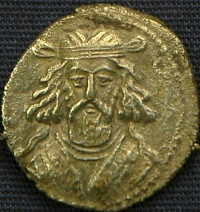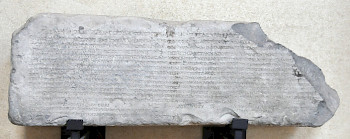Artabanus II
Artabanus II: Arsacid king of the Parthian Empire (r.10-38).
Accession

Shortly after the violent death of king Phraataces, the Parthian nobility elected Orodes III as king.note He was a son of Phraates IV and, therefore, Phraataces' younger brother. According to Flavius Josephus, his reign was as short as it was cruel, and in 8 CE, he was assassinated.note
Orodes was replaced by his brother Vonones I, who had been educated in Rome as guest/hostage of the emperor Augustus.note Josephus and Tacitus both tell us that the Parthians soon regretted that they were now ruled by someone who was, as former hostage, something like a former slave.note
So, a group of Parthians invited Artabanus II, also a member of the Arsacid family and (according to Josephus) "king of Media", to become king of Parthia.note Unless this refers to Media Atropatene, an independent state in what is now Azerbaijan where Artabanus had been ruler, it is more likely that Artabanus had been living among the Dahae, a tribe on the plains of Central Eurasia, as Tacitus tells us.note
Civil War
Vonones, who still had supporters, first defeated Artabanus,note but lost a second battle. Artabanus forced his rival to retreat to Seleucia on the Tigrisnote and captured the Parthian capital Ctesiphon. Vonones fled to Armenia and from there returned to the Roman Empire.note

Although Artabanus demanded the extradition of Vonones, the emperor Augustus refused thisnote but also refused to support the defeated Parthian leader. Instead, he was kept in custody in Syria,note but it seems that Vonones continued to interfere in the Parthian Empire.note
In spite of this success, Artabanus' coup was incomplete. He ordered the execution of several Arsacid princes and had to cope with a Jewish revolt in Babylonia. Because the Jewish commanders Anilai and Asinai were able to defeat the first army sent against them, Artabanus decided to conclude an alliance with them.note They built forts and were a state-in-the-state from c.18 to c.33 CE.
In 18 CE, Artabanus sent envoys to the Roman prince Germanicus, who was visiting the eastern provinces of the Roman Empire, to complain about Vonones' interference, and Germanicus sent Vonones to Pompeiopolis in Cilicia.note When Vonones tried to escape (19 CE), he was killed by his guards.note
Affairs in Armenia
In 34 CE, after the death of Artaxias III Zeno of Armenia, Artabanus installed his son Arsaces as king of Armenia. As a countermeasure, the new Roman governor in Syria, Lucius Vitellius, invited Mithridates, a brother of the king of the West-Caucasian state of Iberia (modern Georgia), to seize the Armenian throne. The result was a full-scale war between the Armenians and Iberians, in which nomads from Central Eurasia played a role as well. When Artabanus of Parthia tried to intervene, Vitellius ordered his legions (III Gallica, VI Ferrata, X Fretensis and XII Fulminata) to prepare for war (late 35?).
This was too much for Artabanus, who backed off and accepted the pro-Roman Mithridates of Iberia as the new king of Armenia. This was a great loss of face and many Parthians now started to ignore their oath of loyalty to Artabanus. At this moment, Vitellius introduced a Tiridates II, a Parthian prince who had been living in Rome, and escorted him across the Euphrates, where the new Parthian leader was welcomed by several Parthian noblemen. Prince Tiridates continued to Seleucia and Ctesiphon, where a member of the Sûrên-clan crowned him king (36).
However, the new ruler hesitated too long and gave his rival, Artabanus II, who had found hospitality with king Izates of Adiabene, a second chance: using Scythian mercenaries, he marched on Seleucia and forced Tiridates to return to Vitellius, who could not intervene because there were problems in the south.
It may have been in late 37 or early 38 that Artabanus met Vitellius. The Parthian king, who had regained his throne, did obeisance to the standards of the Syrian legions, acknowledged Rome's superiority, and recognized that the crown of Armenia was not his to give away. It was one of the greatest triumphs of Rome's eastern policy.
One year later, Artabanus died. He was succeeded by his son Vardanes I,note who appears to have been his father's co-ruler since 29 CE.
Note
The chronology of the Arsacid kings of the Parthian Empire is less well-understood than, for example, the sequence of Seleucid and Ptolemaic kings or the emperors of Rome. This information is based on the researches by G.R.F. Assar, as published in "Iran under the Arsakids, 247 BC – AD 224/227" in: Numismatic Art of Persia (2011).